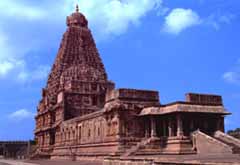
A
temple is the house of God and a place of worship for all.
Although God is Omnipresent and His worship can be done in all
places, still His presence is felt more in a temple, than
anywhere else. Hindu temples are built, strictly by the rules
of Agamic Text.
A temple mainly contains a
Garbhagrahamm – a stead containing the image of
God, The Vimanamn – a structure over the Garbhagrahamm,
Ardhamandapam – a corridor in front of the Garbhagrahamm, Prakaram
– a pathway around the Garbhagrahamm, and the Gopuram -
the main gateway of the temple.
According
to the Tirumular "Our body is a temple". The
great cosmos is reflected in the human body. The Garbhagrahamm
is the seat of the God and it becomes a storehouse of spiritual
power through the prayers and the resonance of mantras. The
position where the main deity is installed is compared to the
forehead of human, where Lord Siva’s third eye is
situated. That’s why kumkum and vibhoodhi are put on the
forehead. The Vimanamm over the Garbhagrahamm attracts holy
powers from the cosmos, like our nose attracts pranavayu
(oxygen) from air. The big toe of the leg is an important part
of the body where in all the nerve systems of the body end
there. It is a custom in Hindu way of life that one should
salute a saint by laying down his body on the earth and by
touching the tip of the big fingers of the legs of the saint.
This is the reason why Raja Gopuram is considered as the
gross body of the
Deity installed in the Temple and devotees unable to visit
the Temple simply consider the Raja Gopuram itself as the Deity
and offer their obeisance from wherever they are.
Generally,
Raja Gopuram consists of an odd number of stories - 3, 5, 7, 9
etc. Three represents the three states - waking, dream and deep
sleep - in which we gain all our experiences. Five indicates the
five senses through which we experience the outer world; seven
signifies, the mind and intellect in addition to the five
senses; and nine represents the above seven to addition to ego
and the bliss . The significance of entering through the Raja
Gopuram is that when one visits a Temple, one should turn his
antakarana or inner equipment (consisting of the five
senses, mind, intellect, ego and heart through which he
experiences the outer world), toward the Deity installed in the
Temple and attempt to merge with the Deity.
The
Garbhagraham is dark, and its walls are largely undecorated.
This starkly contrasts the exterior of the temple, which is
often highly ornate and replete with thousands of sculpted
images. The
darkness of the sanctum reflects its function as a
"womb house,", or offers an
interpretation that God resides in each individual. As
devotees work their way from the exterior of the temple to the
sanctum, they shed the influences of the material world and find
their centre of being. They become one with God.
Such a journey can be within oneself if we understand
that our body is the abode of GOD.
Courtesy
: South Indian Society, Deepavali souvenier 2003





